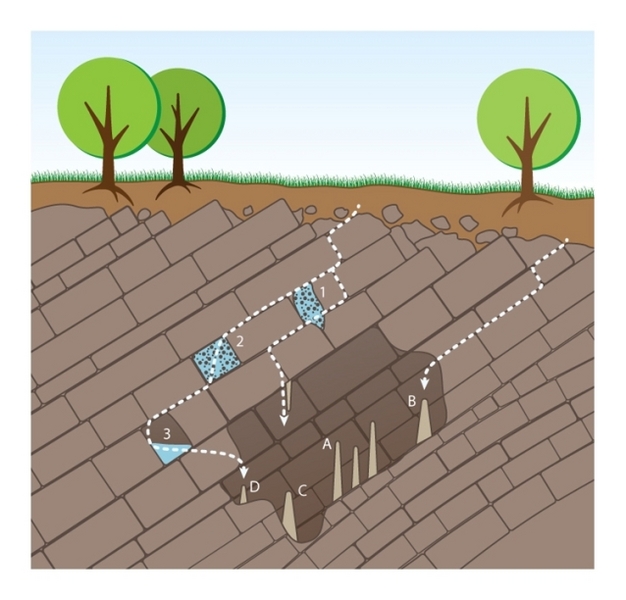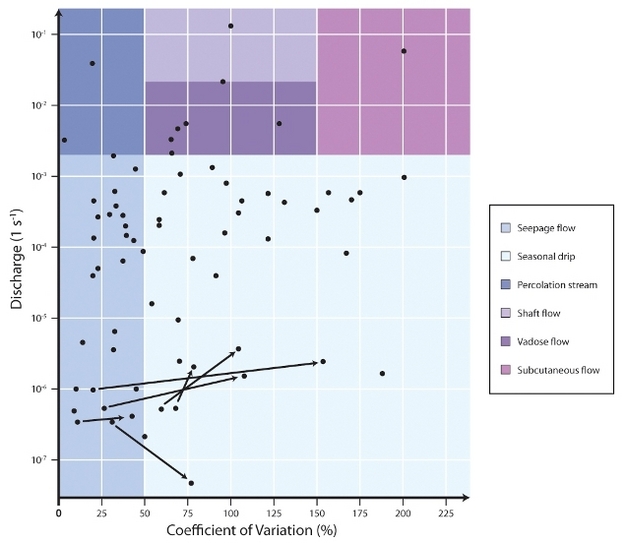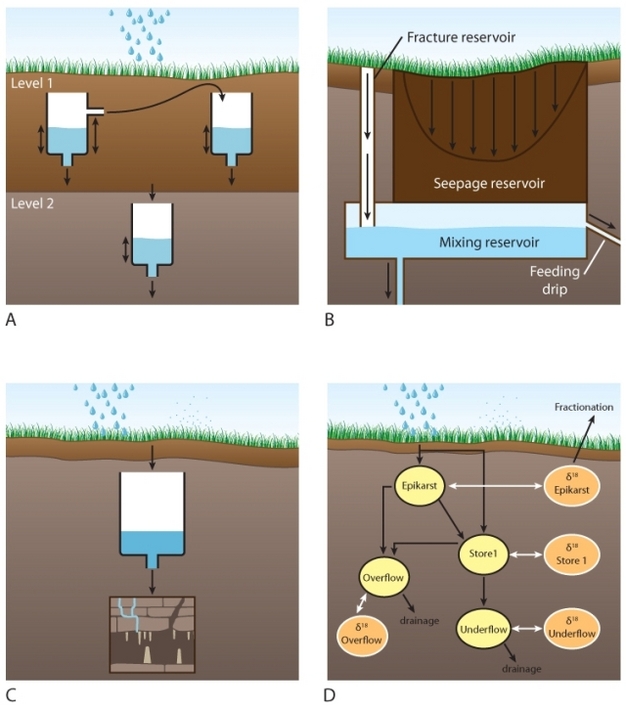« Prev Next »

Recent research has established speleothems (mineral deposits growing in caves) as one of the most important archives of past environments and climates. Here we are concerned with the most common calcareous types that grow within the unsaturated zone of karstified carbonate rocks (i.e., partly or completely lithified carbonates containing significant post-depositional cavities). The properties of these rocks significantly influence the delivery of water that supply the raw ingredients for speleothem growth, and hence our focus in this article on dripwater hydrology. We focus on the ‘standard case,' where karstification occurs by infiltration of meteoric water that has been acidified by soil-derived carbon dioxide, rather than by fluids rising from depth. The focus on dripwater offers a complementary perspective to the usual emphasis in karst hydrology on the fast transmission of water to conduits emerging at springs that are important for water supply (Ford & Williams 2007).
Properties of Carbonate Rocks that Influence Dripwater Hydrology
Carbonate sediments are converted to rocks by sets of diagenetic processes in marine, meteoric, or burial environments. Many carbonates become tightly cemented, and are sometimes dolomitized, during burial, but then are exposed to karstification by freshwater when they are uplifted. When freshwater contacts carbonate, particularly where carbon dioxide pressures are raised in soil zones, calcium carbonate dissolution occurs. Because primary cavities are small and poorly connected (and tend to be absent in pre-Mesozoic carbonates), matrix permeability is low. As a consequence, fluid movement occurs preferentially along lithological boundaries where slightly enhanced porosity is already developed (inception horizons) or fractures generated by small tectonic movements or gravitational disturbance. Significant karstification, including the development of caves, can occur over timescales of 104–106 years (Dreybrodt 1996). In a mature cave system, water drains efficiently underground, leading to unsaturated conditions near the surface, allowing degassing of CO2-rich percolating water and the formation of speleothems. In these settings, drainage of infiltrating water tends to occur sub-vertically (Figure 1), but is principally guided by networks of fractures (or bedding, where it is inclined). The density of joints (master fractures) is inversely proportional to thickness of beds (Klimchouk & Ford 2000). In well-lithified carbonate rocks, what is often called matrix permeability in reality consist of sets of micro-fractures. This enables water storage to occur such that in some slow-flowing drips, mean water ages deduced from tracer studies may reach periods of years (Kluge et al. 2010) to decades (Kaufman et al. 2003). Figure 1 illustrates a range of scenarios for speleothem development beneath segments of carbonate rock with different properties, Figure 2 illustrates a range of speleothem forms, and Figure 3 exemplifies the importance of fracture flow shown by a line of stalactites.



Dripwater Hydrology — Empirical Observations and Theoretical Models
The only method of determining the actual nature of water movement to an individual speleothem is through empirical observations of discharge within the caves. Early studies used manual or tipping-bucket automated gauges (e.g., Gunn 1974) which enabled the development of the first conceptual models of cave dripwater hydrology. Smart & Friederich (1987), and later Baker et al. (1997) classified waters by their mean drip rate and drip variability. Most stalagmite dripwaters were characterised by a discharge of <10-5 L s-1 and a CV (coefficient of variation, i.e., relative standard deviation) of between 10 and 200%. Higher CVs were associated with dripwaters that displayed a significant seasonal variation in flow regime, with an apparent increase in the proportion of seepage waters routed via preferential flow as CV increases. Figure 4 presents a summary of speleothem forming water fluxes after Baker et al. (1997), showing a lack of relationship between flow variability and mean discharge, and significant inter-annual variability in water flux (mean and variability) between years.

Significant improvements to our understanding of water movement to speleothems have come from the development of instruments to continuously measure drip rates in caves. Genty & Deflandre (1998) monitored drip-waters below a stalactite in the Père Nöel Cave, S. Belgium, for more than five years. Each year there was a pronounced period of low-flow in summer coinciding with the development of a soilwater deficit. They also identified periods of water flushing from the soil or epikarst, indicating piston, or displacement flow, with sequential water movement through linked water stores. Additional high frequency, low amplitude variations in drip-water discharge were inversely correlated with air pressure, suggesting two-phase flow. Baker & Brunsdon (2003) continuously monitored six drip sites for up to four years at Stump Cross Caverns, UK, and also observed two-phase flow and non-linear drip rate behaviour. Figure 5 presents a drip logger data from multiple sites at Cathedral Cave, Wellington responding to a single recharge event. Non-linear behaviour of water movement is widely observed across these studies at drip rates of ~1 drip/minute or higher, and has also been observed at the much greater discharge observed in karst springs (Labat et al. 2000), suggesting that this behaviour was possible at a wide range of water movement rates. One might hypothesize that non-linear behaviour in speleothem-forming drip water discharge is to be expected where water movement is affected by secondary porosity.

Recently, quantitative hydrological models of water movement to speleothems have been developed (Fairchild et al. 2006, Baker et al. 2010, Baker & Bradley 2010, Bradley et al. 2010). To date, these have taken the form of simple lumped parameter models, where the hydrology is represented by one or more interconnected reservoirs (Figure 6). The reservoirs represent stored water, which may be within dissolutionally widened fractures or overlying caves, which may be water-, air-, or sediment-filled. Typically, water is routed directly between reservoirs to represent fractures. Where high matrix permeability or dense networks of micro-fractures occurs, this is typically modelled with a proportion of flow with a lagged and damped response of the recharge. These simple hydrological models can capture some of the basic characteristics observed by automated drip loggers such as non-linear flow responses to water input, but more complex models are still needed to successfully model dripwater chemistry (Fairchild et al. 2006).

In many parts of the world, water supply to speleothems over time is non-linear due to recharge occurring only when the precipitation>evapotranspiration threshold is passed, although localized recharge through macropores is always possible. Coupled with the complexity of subsurface flow routes, such as overflow behaviour from storage reservoirs, water movement to speleothems can be expected to display non-linear behaviour. This could be on a seasonal basis, where dripping may even cease, or on the longer-term. Where a stalagmite is fed by a substantial amount of long-lived stored water, candlestick-shaped stalagmites may result: this stored water means that these stalagmites may have a damped influence from the surface atmosphere, soil, and epikarst. For speleothems fed by both reservoir and fracture components, a long growth duration might be expected if fed by a significantly large reservoir compared to water outlets, but with decreasing reservoir size, non-linear water supply is increasingly likely, ultimately leading to seasonal or episodic growth and more complex growth shapes.
Chemical Changes Related to Hydrology
Preservation of Hydrological Signals in Speleothems
The effects of hydrological change are seen in the morphology and in the physical and chemical microstructure of speleothems. Figure 7 illustrates a set of stalagmites from Refugio Cave, Spain, a cave less than 15 m below the surface within fractured dolomitic marbles (Mudarra et al. 2009). The density of stalactites suggests that the drip water hydrology is dominated by matrix or abundant micro-fractures rather than fracture flow. Storage is limited, however, since flow of many drips ceases in the summer. On the left of the field of view are a series of ‘candlestick' shaped stalagmites. They show a common pattern of variation in diameter, with wider portions reflecting higher drip discharge (Kaufmann 2003), and in cross-section have growth hiatuses associated with narrower portions. This illustrates the clear role that hydrology makes to maintaining the growth and controlling the diameter of the stalagmites. Figure 8 illustrates successive annual fluorescence laminae in a stalagmite from Uamh an Tartair, Scotland, indicative of enhanced flushing of organic matter from the overlying peaty soils into caves during the autumn season. This cave is less than 20 m from the surface and formed in Cambro-Ordovician dolomite (Fuller et al. 2008). Matrix porosity would be negligible and drip water hydrology dominated by fracture flow. Stalagmites at this site have been shown to contain thousands of years of continuous fluorescent annual laminae, which requires the presence of both a fracture flow component to rapidly transport discrete fluorescent laminae, and sufficient storage to maintain drip rate (Proctor et al. 2000). Finally, Figure 9 illustrates chemical data illustrating a pattern of covarying increases in magnesium in strontium in a cave (Clamouse, southern France), which displays a characteristic response of prior calcite precipitation in response to seasonal and longer-term droughts (McMillan et al. 2005). The gradual nature of the changes reflects the seepage flow from abundant secondary matrix porosity that has been generated by partial dedolomitization of the host Mesozoic carbonates.



Summary
Acknowledgements
The authors would like to acknowledge the advice and comments of three reviewers of this article.
Glossary
Dedolomitisation: See dolomitised
Diagenetic: Diagenesis refers to the chemical, physical and biological changes experienced by sediment after its initial deposition and during and after it forms solid rock. During lithification, sediments compact under pressure. Diagenesis occurs when this occurs at relatively low temperatures and pressures, in contrast to metamorphism.
Dolomitized: Dolomitization is the process by which a limestone (CaCO3) is converted to dolomite [CaMg(CO3)2]. Dedolomitization is the reverse process.
Inception horizons: The part of a lithostratigraphic succession that is particularly susceptible to the effects of the earliest cave-forming processes by virtue of physical, lithological, or chemical deviation from the predominant carbonate facies within the formation.
Karstified: Karstification is the process of dissolution of carbonate bedrock by mildly acidic water, normally from water-soluble carbon dioxide. Karstified rocks typically have dissolutionally enhanced fractures or bedding planes, and the process of karstification continues with the formation of caves and underground drainage systems, as well as surface dissolution features.
Lumped parameter models: Lumped parameter models are simplifications of reality, where spatial variations of parameters are ignored, and the system is described by a topology of discrete elements, with parameters that are adjustable.
Macropores: Cavities found with soils which are formed from cracks, plant roots, soil fauna, etc., and which increase the hydraulic conductivity and therefore faster infiltration to the groundwater.
Meteoric: Pertaining to the atmosphere or weather. Diagenesis under meteoric environments therefore relates to processes caused by exposure to the atmosphere (e.g., karstification). Meteoric groundwater differentiates infiltrating rainwater from other groundwater sources.
Non-linear: A non-linear system is one where the output is not directly proportional to its input.
Permeability: Permeability of aquifers refers to the ease with which they transmit water. This permeability may be a primary feature of the aquifer (e.g., matrix permeability), or it might be a secondary feature (e.g., due to dissolution along inception horizons).
Speleothems: Carbonate precipitates forming within caves, including flowstones (formed at the base of flowing water), stalactites (from cave-roof drip sources), and stalagmites (from drip-water reaching the cave floor). Stalagmites are typically used for palaeoclimate reconstruction as they grow upwards from the floor and have a relatively simple growth stratigraphy compared to other forms.
Two-phase flow: Where both gas and liquid are involved in the flow system. For example, in a karst system, where air becomes trapped within water-filled fissures.
Unsaturated zone: The part of the Earth below the land surface and above the phreatic zone (zone of saturation), which is marked by the water table. It is also known as the vadose zone.
References and Recommended Reading
Baker, A. & Bradley, C. Modern stalagmite δ18O: Instrumental calibration and forward modelling. Global Planetary Change 71, 201-206 (2010).
Baker, A. & Brunsdon, C. Non-linearities in drip water hydrology: An example from Stump Cross Caverns, Yorkshire. Journal of Hydrology 277, 151-163 (2003).
Baker, A. et al. Annual banding in a cave stalagmite. Nature 364, 518-520 (1993).
Baker, A., Barnes, W. L. & Smart, P. L. Stalagmite drip discharge and organic matter fluxes in Lower Cave, Bristol. Hydrological Processes 11, 1541–1555 (1997).
Baker, A. et al. Decadal-scale rainfall variability in Ethiopia recorded in an annually laminated, Holocene-age, stalagmite. The Holocene 20, 827–836 (2010).
Baldini, J. U. L., McDermott, F. & Fairchild, I. J. Spatial variability in cave drip water hydrochemistry: Implications for stalagmite paleoclimate records. Chemical Geology 235, 290–304 (2006).
Borsato, A. et al. Trace element distribution in annual stalagmite laminae mapped by micrometer-resolution X-ray fluorescence: Implications for incorporation of environmentally significant species. Geochimica Cosmochimica Acta 71, 1494–1512 (2007).
Bradley, C. et al. Hydrological uncertainties in the modelling of cave drip-water δ18O and the implications for stalagmite palaeoclimate reconstructions. Quaternary Science Reviews 29, 2201–2214 (2010).
Dreybrodt, W. Principles of early development of karst conduits under natural and man-made conditions revealed by mathematical analysis of numerical models. Water Resources Research 32, 2923–2935 (1996).
Fairchild, I. J. & Baker, A. Speleothem Science. From Process to Past Environment. Chichester, UK: Wiley-Blackwell, 2012.
Fairchild, I. J. et al. Controls on trace element (Sr-Mg) compositions of carbonate cave waters: Implications for speleothem climatic records. Chemical Geology 166, 255–269 (2000).
Fairchild, I. J. et al. Modelling of dripwater hydrology and hydrogeochemistry in a weakly karstified aquifer (Bath, UK): Implications for climate change studies. Journal of Hydrology 321, 213–231 (2006).
Ford, D. & Williams, P. Karst Hydrogeology and Geomorphology. Chichester, UK: John Wiley, 2007.
Fuller, L. et al. Isotope hydrology of dripwaters in a Scottish cave and implications for stalagmite palaeoclimate research. Hydrology and Earth System Science 12, 1065–1074 (2008).
Genty, D. & Deflandre, G. Drip flow variations under a stalactite of the Pere Noel cave (Belgium). Evidence of seasonal variations and air pressure constraints. Journal of Hydrology 211, 208–232 (1998).
Gunn, J. A model of the karst percolation system of Waterfall Swallet, Derbyshire. Transactions of the British Cave Research Association 3, 159–164 (1974).
Kaufman, A. et al. The vadose flow above Soreq Cave, Israel: A tritium study of the cave waters. Journal of Hydrology 273, 155–163 (2003).
Kaufmann, G. Stalagmite growth and paleoclimate: The numerical perspective. Earth and Planetary Science Letters 214, 251–266 (2003).
Klimchouk, A. & Ford, D. "Lithologic and structural controls of dissolutional cave development," in Speleogenesis. Evolution of Karst Aquifers, eds. A. B. Klimchouk et al. (Huntsville, AL: National Speleological Society, 2000) 54–64.
Kluge, T. et al. Dating cave drip water by tritium. Journal of Hydrology 394, 396–406 (2010).
Labat, D., Ababou, R. & Mangin A. Rainfall-runoff relations for karstic springs. Part I: Convolution and spectral analysis. Journal of Hydrology 238, 123–148 (2000).
McMillan, E. A. et al. Annual trace element cycles in calcite-aragonite speleothems: Evidence of drought in the western Mediterranean 1200-1100 yr BP. Journal of Quaternary Science 20, 423–433 (2005).
Mudarra, M. et al. "Monitoring dripwater chemistry in El Refugio cave (southern Spain) as a contribution to understanding infiltration and speleogenetic processes in karst aquifers," in Proceedings of the 15th International Congress of Speleology (Kerrville, TX: International Union of Speleology, 2009) 1620–1625.
Proctor, C. J. et al. A thousand year speleothem proxy record of North Atlantic climate from Scotland. Climate Dynamics 16, 815–820 (2000).
Smart, P. L. & Friederich, H. "Water movement and storage in the unsaturated zone of a maturely karstified carbonate aquifer, Mendip Hills, England," in Proceedings of the Conference on Environmental Problems in Karst Terranes and their Solutions. (Dublin, OH: National Water Well Association, 1987) 59–87.
Tooth, A. F. and Fairchild, I. J. Soil and karst aquifer hydrological controls on the geochemical evolution of speleothem-forming drip waters, Crag Cave, southwest Ireland. Journal of Hydrology 273, 51–68 (2003).






























